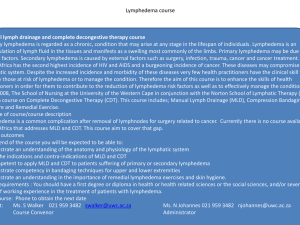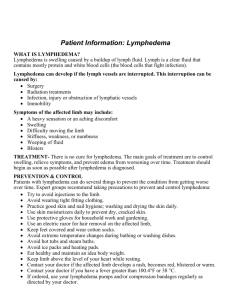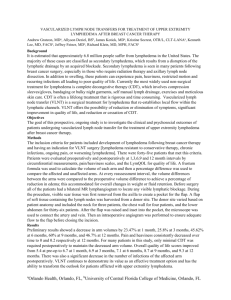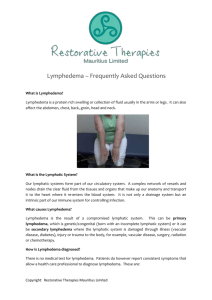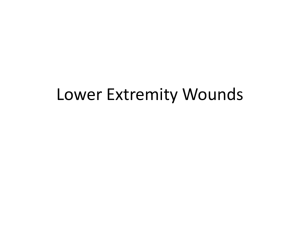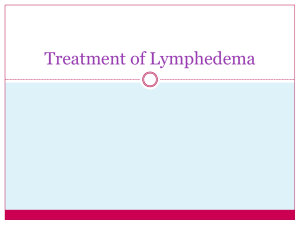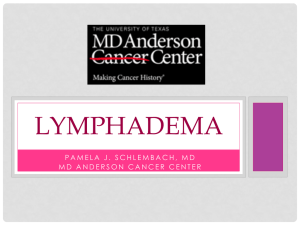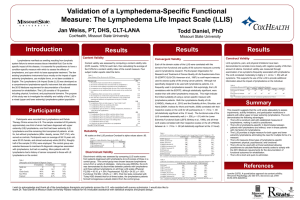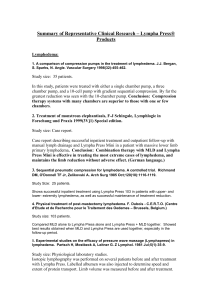Lymphedema - American Medical Technologists
advertisement
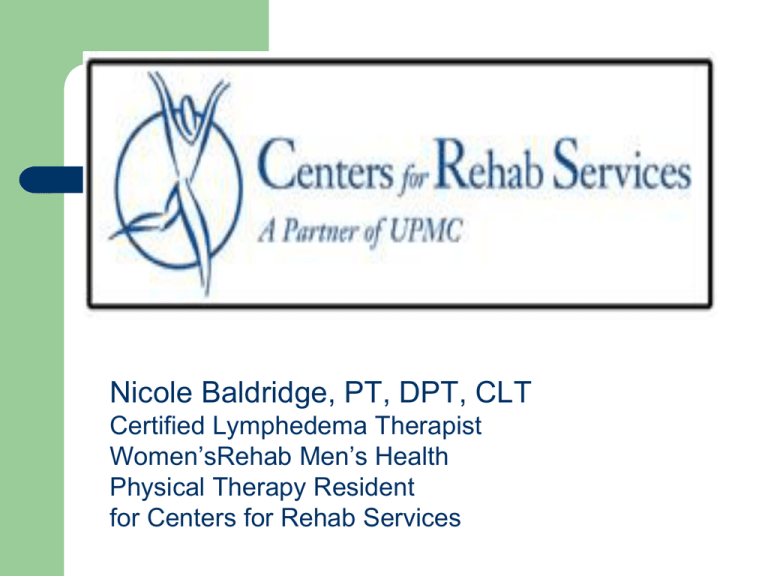
Nicole Baldridge, PT, DPT, CLT Certified Lymphedema Therapist Women’sRehab Men’s Health Physical Therapy Resident for Centers for Rehab Services Lymphedema Diagnosis and Therapy Lymphedema Secondary Lymphedema Primary Lymphedema Lymphedema An abnormal accumulation of protein-rich fluid in the interstitium, causing chronic inflammation and reactive fibrosis of the affected tissues Usually in an extremity, but can also occur in the head, neck, genitals, and abdomen Lymphedema Affects 1% of the American population (2.5 million people) Still poorly understood in the medical community Largest cause of lymphedema in the world is Filariasis (considered secondary lymphedema) Filariasis is a parasitic infiltration into the lymphatics that is very common in third world countries (affects 90 million people) Types of Lymphedema Primary lymphedema is a result of lymphatic dysplasia. – – May be present at birth Can develop later in life without known cause Secondary lymphedema is much more common. – Result of surgery, radiation, injury, trauma, scarring, or infection of the lymphatic system Primary lymphedema Lymphangiodysplasia – general malformation Hypoplasia – fewer than normal # of lymph collectors Aplasia – absences of collectors in a distinct area Milroy's Disease is congenital lymphedema evident at birth Meige’s Syndrome is primary lymphedema onset at puberty (lymphedema praecox) Lymphedema Tardum is primary lymphedema onset after age 35 Secondary lymphedema There is a known cause for the presence of edema Surgery: breast cancer, melanoma, prostate/bladder cancer, lymphoma, ovarian cancer, hip replacements Radiation therapy Trauma – scarring, crush injury Infection CVI Obesity Self-induced Stages of Lymphedema Latency Stage Transport Capacity is reduced No visible edema Subjective complaints of heaviness, achiness Stage 1 Reversible lymphedema Accumulation of protein-rich edema Pitting Reduces w/elevation (no fibrosis) Stage 2 Spontaneously Irreversible Lymphedema Accumulation of protein-rich edema Pitting becomes progressively difficult Fibrosis Stage 3 Lymphostatic Elephantiasis Accumulation of protein-rich edema Fibrosis, sclerosis, skin changes, papillomas, hyperkeratosis Tissue Changes in Lymphedema Connective tissue cells (fibroblasts) proliferate Collagen fibers are produced Fibrotic changes, sclerosis and induration Fatty tissue increases Angiosarcoma Can develop after long-standing lymphedema “Stewart - Treves Syndrome” Angiosarcoma after mastectomy was first described in 1948 by Stewart and Treves Signs: reddish-blue and blackish-blue lumps that rapidly increase in size, bleed easily and ulcerate at an early stage Very rare & poor prognosis Stewart-Treves Syndrome Lymphedema is a disease. All other edemas are symptoms. There is no cure for lymphedema. There is only management. Diagnosis of Lymphedema Physical exam and history are most important. Characteristics of Benign Lymphedema Slow onset, progressive Pitting in early stages Cellulitis is common Rarely painful but discomfort is common Skin changes – hyperkeratosis, papillomas, lichenification Ulcerations are unusual Starts distally – – – – Toes square, positive Stemmer’s sign Dorsum of foot “buffalo hump” Loss of ankle contour Asymmetric if bilateral History What is the reason for the swelling? How long has the extremity been swollen? How fast did the edema progress/develop? What are the underlying diseases? Is there pain? Other conditions? Other treatments? Medications? Inspection Location of swelling (distal or proximal) Any skin changes Lymphatic cysts, fistulas Ulcers Scars or radiation burns Papillomas Hyperkeratosis Palpation Temperature – indicative of infection Stemmer sign is (+) when a thickened cutaneous fold of skin at the dorsum of the toe or finger cannot be lifted or is difficult to lift. Positive Stemmer’s sign is indicative of lymphedema. Skin folds Pitting Fibrosis Muscular status Diagnostic Tests Direct lymphography: invasive, oily contrast injected into a surgically exposed lymphatic vessel. Damaging. Has been replaced by CT, MRI, US. Lymphoscintigraphy: noninvasive, assesses dynamic process in superficial and deep lymphatics CT MRI These tests are often not performed due to lack of clinical importance Differential Diagnosis Lipedema Chronic venous insufficiency Acute deep vein thrombosis Cardiac edema Congestive heart failure Malignancy/active cancer Filariasis Myxedema Complex regional pain syndrome Lipedema Mainly in women Bilateral, symmetrical edema from iliac crest to ankles Dorsum of feet never involved (-) Stemmer’s sign Little or no pitting No cellulitis Painful to palpation Bruise easily CVI Gaiter distribution Non-pitting Brawny Hemosiderin staining Fibrosis of subcutaneous tissue Atrophic skin Acute DVT Sudden onset Unilateral Painful Cyanosis (+) Homan’s sign Potentially lethal (PE) Diagnosis with venous doppler Not treatable with PT Cardiac edema Right heart insufficiency Greatest edema distally Always bilateral Pitting Complete resolution with elevation No pain May treat with PT if cleared by Cardiologist Congestive Heart Failure Bilateral heart failure Pitting edema Orthopnea, paroxysmal noctural dyspnea, DOE Jugular venous distension Diagnosis with physical exam, chest x-ray, cardiac echo Malignant lymphedema Pain, paresthesia, paralysis Central location, proximal onset Rapid development, continuous progression Swelling and nodules in supraclavicular fossa Hematoma-like discoloration (angiosarcoma) Ulcers and non-healing open wounds Recurrent malignancy Filariasis Prevalent in 3rd world countries; Can still be treated successfully with CDT. Most therapists in the US will never encounter Filariasis. Lymphedema Treatment Options Pneumatic compression pump Surgery Complete decongestive therapy (CDT) Elastic support garments Medications Pneumatic Compression Pumps Advantages: 1. Can be used at home by patients 2. Fast application 3. Financially lucrative for DME vendors ($4000 per pump) Pneumatic Compression Pumps Disadvantages: 1. Disregards the fact that the ipsilateral trunk can be involved in the lymphedema 2. In LE edema, the pump can cause genital edema; in UE edema, the pump can cause breast edema 3. Does not address tissue fibrosis and extended use can cause additional fibrosis 4. Requires many hours a day with the affected limb elevated 5. The pump can traumatize residual, functioning lymphatics, especially of the UE Pneumatic Compression Pumps More disadvantages than advantages, but there are times when pumps are an appropriate choice Use ONLY IF: – – Teach the patient MLD to clear the trunk first Use recommended safe settings UE 30-40 mmHg LE 50-60 mmHg CVI patients will benefit from a pump Surgery Microsurgical techniques Liposuction Debulking/Reduction procedures Why surgical options do not always succeed… A blocked system must be made intact The direction of flow must be correct The inflow of the reconstructed system must be adequate and the outflow must remain open Patency must be lasting History of Complete Decongestive Therapy…. Emil Vodder, Ph.D., P.T. discovered that massage therapy boosted people’s immune systems. They began to massage swollen lymph nodes and noticed common colds improving. He created his first publication of this and coined the term MLD (manual lymph drainage). History of Complete Decongestive Therapy…. Michael Foeldi, M.D. and Ethel Foeldi, M.D. In the 1980’s, Prof. Foeldi advanced lymphedema considerably by combining MLD, bandaging, exercise, skin and nail care into “Complete Decongestive Therapy.” Components of CDT MLD Compression bandaging Exercise Skin and nail care Instructions in self care Manual Lymph Drainage MLD is a gentle manual treatment which improves the activity of the lymph vascular system. In lymphedema, it reroutes the lymph flow around blocked areas into centrally located healthy areas which then can drain into the venous system. Manual Lymph Drainage Manual Lymph Drainage Improves lymph production Increases lymphangio-motoricity Improves lymph circulation and increases the volume of lymph transported Special techniques help break down fibrous connective tissue Promotes relaxation and has an analgesic effect Compression bandaging Short stretch bandages (Rosidal, Comprilan) are applied to increase the tissue pressure in the edematous extremity. Reduces the ultrafiltration rate Improves efficiency of the muscle and joint pumps Prevents re-accumulation of evacuated lymph fluid Helps break down fibrous connective tissue that has developed Exercise Performed with the bandages on or while wearing a compression garment. Active ROM, stretching, strengthening Low exertion Diaphragmatic breathing Increase muscle and joint pumping Increase lymph vessel activity Increase venous and lymphatic return Skin and Nail Care Eliminate bacteria and fungal growth by using medicated powders, hydrocortisone cream where indicated. Reduce the risk of infection by avoiding injury, cleaning all injuries immediately, calling MD at first sign of infection. Self Care Patients should be instructed in the following: – – – – – – – Skin and nail care Infection prevention (cellulitis is very common) Self-bandaging Self-MLD as needed Exercise Donning and doffing compression garment Regular follow-up visits CDT is a Two-Phase Therapy Phase 1 (Treatment Phase) – – – – – Meticulous skin/nail care MLD Compression bandaging Exercise Self care education ** lasts as long as necessary CDT is a Two-Phase Therapy Phase 2 (Maintenance Phase) – – – – – – Patient wears compression garments during the day Patient bandages at night Meticulous skin and nail care Daily exercise MLD as needed Regular follow-up visits **life long maintenance When does CDT fail? Malignant lymphedema Artificial (self-induced) lymphedema Insufficient treatment (only used MLD or improper bandaging) Deviation from CDT protocol Associated illnesses Lack of compliance Active cancer Faulty diagnosis Goals of CDT Volume or size reduction Restore mobility and ROM Infection prevention Improve cosmesis Improve psychosocial morbidity Improve QOL Compression garments Elastic garments are uncomfortable and ineffective if worn while the limb is edematous. Garments do nothing to correct the underlying cause of the edema. Garments are NEEDED after the decongestive phase of CDT to prevent refill. Daytime garments Lymphedema Secondary to Breast Cancer Primary Lymphedema of the Left Leg Primary Lymphedema of Scrotum and Leg Before After resection Night-time garments Night-time Garments What role do medications have? Diuretics: make edema worse; often prescribed, but draw water off protein molecules. Can cause lymphedema to become more fibrotic. Benzopyrones: not FDA approved; stimulate macrophage activity and promote protein proteolysis; theoretically useful; effect is so slow that usefulness is questionable. Includes coumarin, rutosides, diosmin, rutin. DIET No specific diet for lymphedema Reducing water and/or protein intake is ineffective Avoiding obesity is helpful General recommendations are low sodium, high fiber, vitamin rich diets. What role does obesity play? Increased risk of post-op complications such as infection Reduced muscle pumping efficiency within loose tissues Additional fat deposits contribute to arm volume Deep lymph channels are separated by subcutaneous fat Randomized controlled trial comparing a low-fat diet with a weight reduction diet in breast cancer related lymphedema This article was published in the medical journal “Cancer” in May 2007. It was also copy-written by the American Cancer Society in 2007 Results The low-cal group and low-fat group had significant reductions of: body weight – BMI – % body fat **Significant correlation between weight loss and arm volume reduction regardless of the dietary group **unaffected arm also showed volume reduction – Overview This is the first study to examine the role of diet as a possible treatment for BCRL Significant correlation of weight loss and loss of swollen arm volume The type of diet did not affect arm volume reduction…just losing weight! Weight loss in a healthy manner Healthy diet and exercise Insurance coverage…. Medicare does not pay for products – Medicare HMO’s do not pay Medicaid does not pay for products Most Highmark BC/BS, HMO, PPO pay 100% for products UPMC HMO, PPO plans…as of 1/1/08 started following Medicare guidelines, but this is changing to more coverage Insurance obstacles… Frustrating for the therapist because patients need these products to maintain edema and prevent worsening of edema. We recommend products based on what the patient needs or does not need. Often we have to change our recommendations based on what the insurance will reimburse. Actual cost for the patient.… Day garments: – – – Patients need 2 garments every 6 months Custom fit $300-500 per garment Ready to wear $50-150 per garment RTW garments only come S, M, L and in a less effective fabric than custom garments Night garments: custom only, $500-2000 More cost… Keep in mind that all of these costs are what the DME suppliers charge for “private pay.” Bandaging supplies for treatment – – Unilateral UE/LE about $150-200 Bilateral LE >$200 How does this affect you… Most of the DME’s in the area are “out-ofnetwork” with Cigna Out of network cost for these products is extremely high Important to understand how necessary these products are and to consider approval at an “in-network” level. Help for patients… Susan G. Komen Foundation – – Am. Cancer Society – – Breast cancer patients 800.462.9273 Any cancer $300/year 800.227.2345 Nat’l Lymphedema Network – – – www.lymphnet.org Marilyn Westbrook Foundation Also has “Find a Therapist or Treatment Center” THANK YOU! baldridgena@upmc.edu Phone/Address: Centers for Rehab Services Moon Township 1600 Coraopolis Heights Rd Coraopolis, PA 15108 (412) 269-7062 McCandless 9365 McKnight Rd #300 Pittsburgh, PA 15328 (412) 630-9750 WomensRehab at Centers for Rehab Services Specialists in treating lymphedema as well as urinary incontinence, pelvic pain, interstitial cystitis, vulvadynia, fecal incontinence, constipation and other pelvic floor hyper/hypotonicity disorders. Locations: Cranberry, Moon, Gibsonia, Harmar, St. Margaret’s, South Hills, Oakland, Squirrel Hill, McCandless, Delmont, Monroeville, Chippewa Referral Line 1-888-723-4CRS
